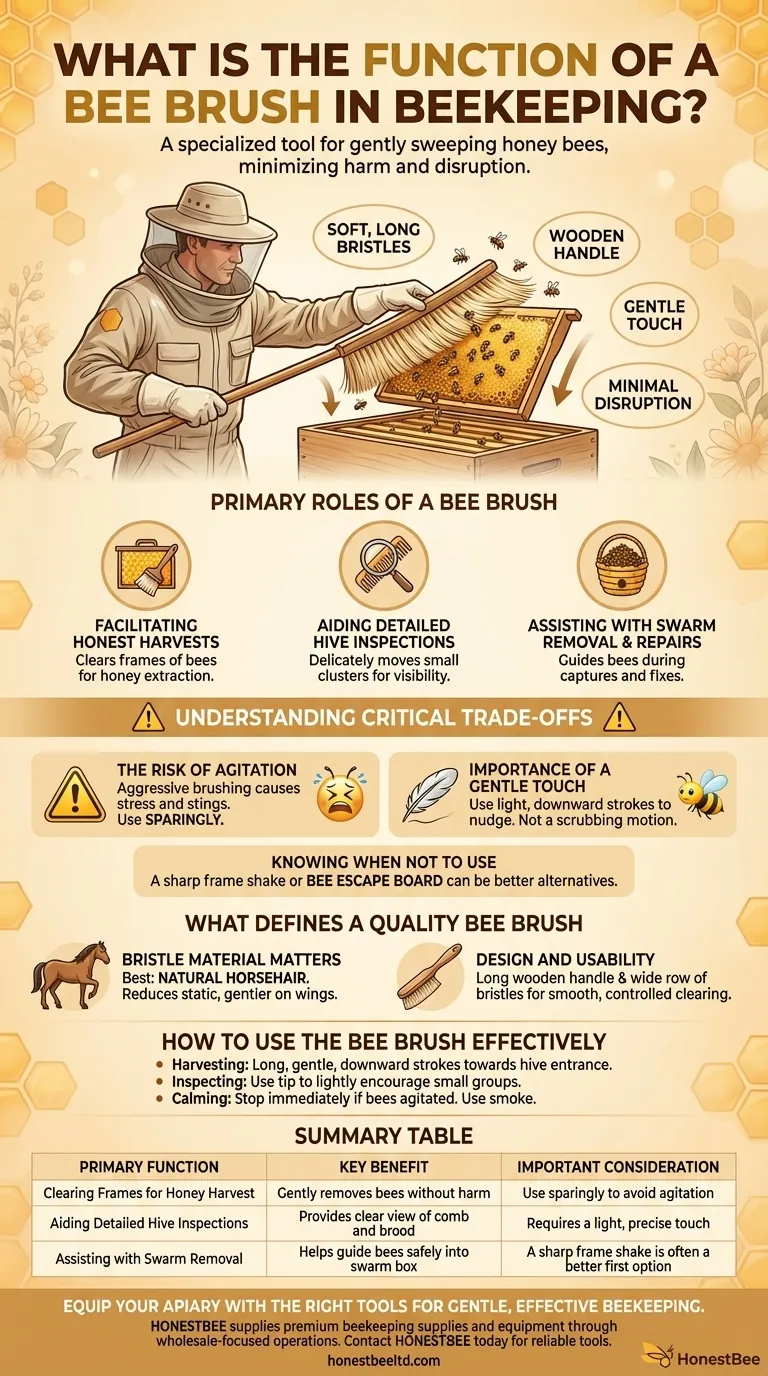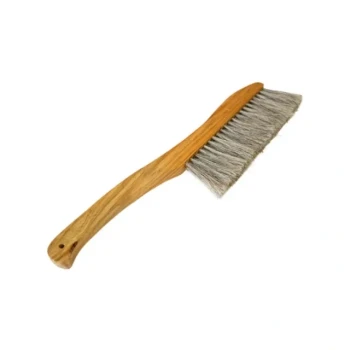In beekeeping, a bee brush is a specialized tool designed with soft, long bristles to gently sweep honey bees off surfaces without causing them harm. Its primary function is to safely clear bees from frames, equipment, or your beekeeping suit, allowing you to perform tasks like hive inspections and honey harvesting with minimal disruption to the colony.
A bee brush is an essential instrument for carefully displacing bees, but its value is defined by its gentle application. While indispensable for clearing frames for honey extraction, beekeepers must recognize that bees can become agitated by brushing, making a light touch and sparing use critical for maintaining a calm hive.

The Primary Roles of a Bee Brush
A bee brush is not an everyday tool, but it is invaluable for specific situations where bees need to be moved from a surface you need to access.
Facilitating Honey Harvests
This is the most common use for a bee brush. Before you can uncap honeycomb and place it in an extractor, the frame must be completely free of bees.
A few gentle, downward sweeps with the brush effectively clears the frame, allowing you to move the honey-filled frame away from the hive.
Aiding in Detailed Hive Inspections
During an inspection, you may need a clear view of a specific section of comb to check for eggs, larvae, or signs of disease.
The tip of a bee brush can be used to delicately move a small cluster of bees aside, providing the visibility you need without disturbing the entire frame.
Assisting with Swarm Removal and Repairs
When capturing a swarm or dealing with a broken piece of comb, a bee brush helps you gently guide or move bees.
It allows you to carefully usher bees into a swarm box or off a damaged area so you can perform repairs, such as reattaching the comb to a frame with rubber bands.
Understanding the Critical Trade-offs
While useful, a bee brush must be used with care and intention. Overuse or improper technique can create more problems than it solves.
The Risk of Agitation
Bees generally dislike being brushed. The sensation is unnatural and can be perceived as an attack from a predator.
Aggressive or rapid brushing will agitate the bees, often causing them to sting the brush bristles and release alarm pheromone, which can escalate the defensiveness of the entire colony. For this reason, the brush should always be used sparingly.
The Importance of a Gentle Touch
The goal is a light, sweeping motion, not a scrubbing one. The long, soft bristles are designed to nudge the bees, encouraging them to move along.
Always brush downwards, towards the entrance of the hive, so that the displaced bees can easily find their way back into the colony.
Knowing When Not to Use a Brush
Often, a better alternative exists. A sharp shake of the frame can dislodge most bees back into the hive with less irritation than brushing. For clearing an entire honey super, a bee escape board is a far more passive and effective method.
What Defines a Quality Bee Brush
Not all bee brushes are created equal. The right materials and design contribute significantly to its effectiveness and gentleness.
Bristle Material Matters
The best bee brushes use natural horsehair. Horsehair does not build up static electricity, which can shock and injure bees.
Brushes with natural bristles also tend to collect less sticky honey and propolis compared to synthetic alternatives, making them easier to clean and gentler on the bees' delicate wings.
Design and Usability
A standard bee brush has a long, wooden handle and a wide row of bristles. This design allows you to clear most of a frame in one or two smooth, controlled passes.
How to Use the Bee Brush Effectively
Think of the bee brush as a tool of finesse, not force. Its proper use is a key skill in calm, confident bee management.
- If your primary focus is harvesting honey: Use long, gentle, downward strokes to sweep bees from the frame towards the hive entrance.
- If your primary focus is inspecting a frame: Use the very tip of the brush to lightly encourage a small number of bees to move aside, rather than brushing the entire surface.
- If your primary focus is calming the hive: Stop brushing immediately if bees become agitated. Set the brush aside and consider using a gentle puff of smoke before proceeding.
Mastering the light touch of a bee brush transforms it from a simple tool into an essential part of effective and respectful beekeeping.
Summary Table:
| Primary Function | Key Benefit | Important Consideration |
|---|---|---|
| Clearing Frames for Honey Harvest | Gently removes bees without harm | Use sparingly to avoid agitation |
| Aiding Detailed Hive Inspections | Provides clear view of comb and brood | Requires a light, precise touch |
| Assisting with Swarm Removal | Helps guide bees safely into a swarm box | A sharp frame shake is often a better first option |
Ready to equip your apiary with the right tools for gentle, effective beekeeping?
For commercial apiaries and beekeeping equipment distributors, using high-quality, purpose-built tools is essential for operational efficiency and colony health. HONESTBEE supplies premium beekeeping supplies and equipment through wholesale-focused operations, ensuring you have reliable tools like gentle horsehair bee brushes that protect your valuable bees.
Contact HONESTBEE today to discuss your wholesale supply needs and discover how our equipment can support your success.
Visual Guide

Related Products
- Wooden Bee Brush with Double-Row Horsehair Bristles
- Wooden Bee Brush with Triple Row Artificial Fiber for Beekeeping
- Plastic Handle Single Row Artificial Fiber Bee Brush
- Premium Triple-Row Horsehair Bee Brush
- Double Row Artificial Fiber Bee Brush for Beekeeping
People Also Ask
- What is the primary use of a bee brush during inspections and extraction? Essential for Gentle Bee Handling
- How is a bee brush used in beekeeping? Master Gentle Bee Handling for Your Apiary
- What are some optional tools that can be useful in beekeeping? Boost Efficiency & Hive Health
- What should be done if the swarm is situated on the bottom of a tree limb? A Guide to Methodical Bee Capture
- How effective are brushes as a smoke alternative in beehives? Avoid Agitating Your Hive



















